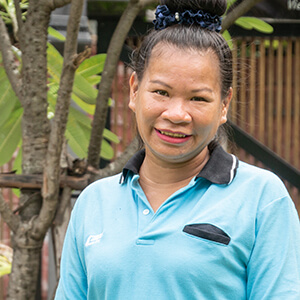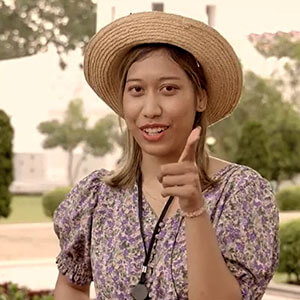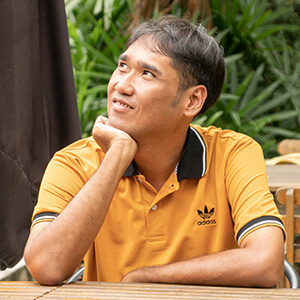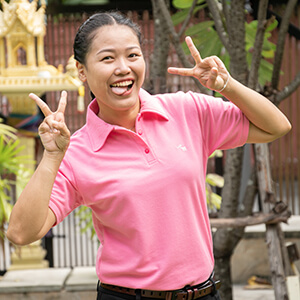1. What is your strategy for navigating Bangkok’s notorious traffic?
Guide Yuut’s Approach: Drawing from years of experience in Bangkok, I can help you navigate the city efficiently through:
- Route expertise: I can suggest the most efficient pathways between major attractions, helping you avoid congestion hotspots
- Public transport mastery: I’ll teach you to confidently use the BTS Skytrain and MRT subway systems, often faster than cars during peak hours
- Rush hour wisdom: We can time our tours to avoid 7-9 AM and 5-7 PM rush hours whenever possible
- Backup solutions: When traffic is unavoidable, I can arrange Grab taxi and alternative transport options
Client Experience: Many visitors specifically request to learn the BTS/MRT systems on their first day, which then allows them to explore independently for the rest of their stay. One client mentioned: “We would like an introduction tour on how to use and navigate Bangkok’s public transportation especially the BTS and MRT to get around Bangkok.”

Prayut ‘Yuut’ Rueang saeng
Tour Guide License No. 1-029268
2. How do you explain Bangkok’s address system to visitors who are completely lost?
Guide Yuut’s Method: I use a practical, visual approach to help demystify Bangkok’s addressing:
- Show the Bangkok directory: I can demonstrate how to read Thai addresses and use landmarks
- Neighborhood orientation: I’ll explain Bangkok’s district system (Sukhumvit, Silom, Chatuchak, etc.) so you understand where you are
- Visual landmarks: I can point out BTS/MRT stations, major hotels, and shopping centers as reference points
- Digital tools: I’ll show you how to use Google Maps effectively with Thai locations
- Emergency backup: I can provide you with your hotel address written in Thai and key phrases for taxi drivers
Pro tip: I always make sure clients can identify their hotel location near to major BTS stations and landmarks before we part ways.

3. What are the real insider tricks to using Tuk-Tuk, taxi, and BTS without getting ripped off?
Guide Yuut’s Insider Knowledge:
Tuk-Tuk Tips:
- Always negotiate the price BEFORE getting in (typical tourist areas: 100-200 THB for short distances)
- I suggest avoiding tuk-tuks near major tourist sites as they often take you to commission shops
- Honest drivers exist, but be careful of “special deals” or “free” rides to gem shops
Taxi & Grab Strategy:
- Use Grab app as your primary choice because transparent pricing, no haggling needed
- For regular taxis, insist on using the meter (“meter ka/krap”)
- Always carry small bills (20, 50, 100 THB notes) for exact change
BTS/MRT Mastery:
- Think about day passes for unlimited rides (around 140 THB for BTS, 120 THB for MRT)*
- Peak hours: 7-9 AM and 5-7 PM get very crowded
- Download BTS/MRT apps for route planning
- Keep small change for ticket machines
*Prices subject to change
Client insight: One regular client noted: “We prefer to use public transportation (BTS/MRT) but if need be we can go on Taxi or Grab.” This flexibility can save both time and money.
4. Which food markets do locals shop at vs. where tourists go?
Guide Yuut’s Local Knowledge:
Where Locals Often Shop:
- Wang Lang Market: Authentic riverside market where Bangkok families buy fresh produce and prepared foods
- Chinatown Market (Yaowarat): Real local shopping especially for Chinese-Thai specialties
- Khlong Toei Market: The city’s largest fresh market (early morning is best)
- Or Tor Kor Market: Higher end local market with excellent quality produce
Tourist Markets (Still Worth Visiting):
- Chatuchak Weekend Market: Mix of tourist items and local goods
- Floating Markets: Mostly tourist-focused but culturally interesting
Client Experience: Multiple clients specifically request Wang Lang Market, with one saying: “We are interested in going on a canal tour and visiting the Wang Lang Market. We love Thai food and are keen to try some interesting street food.” Another client mentioned wanting to explore Wang Lang specifically: “I want to try everything but only have so much room in my tummy… I would love someone who would accompany me at the Market for just a couple of hours to go wild on the street food.”
5. If you had just 48 hours to show Bangkok to your best friends, what would your ideal itinerary be?
Guide Yuut’s Suggested 48-Hour Bangkok Experience:
Day 1: Historic & Cultural Core
- Morning: Grand Palace & Wat Phra Kaew (Emerald Buddha)
- Midday: Wat Pho (Reclining Buddha) with traditional Thai massage
- Afternoon: Cross river to Wat Arun (Temple of Dawn) via boat
- Late afternoon: Canal tour through Bangkok’s waterways
- Evening: Chinatown street food tour on Yaowarat Road
Having spent 10 years as a monk, I can offer deeper insights into the spiritual significance and proper etiquette at these sacred sites.
Day 2: Local Life & Modern Bangkok
- Morning: Wang Lang Market authentic local experience
- Midday: BTS Skytrain to explore Siam area
- Afternoon: Jim Thompson House for silk and culture
- Late afternoon: Lumpini Park to spot monitor lizards
- Evening: Rooftop bar for sunset views over the city
Alternative Option: Replace Day 2 with Ayutthaya ancient capital day trip for deeper historical immersion.
Client validation: This itinerary reflects what many clients specifically request, combining “temples, grand palace, the river (boat trip), floating market, tuk tuk ride, food and flower markets, street food, Chinatown.”
6. Which famous restaurants do you avoid and what local alternatives do you recommend instead?
Guide Yuut’s Personal Restaurant Recommendations:
My Perspective on High-Profile Spots:
- Jay Fai: While Michelin-starred and respected by many, I personally find it very expensive and feel there are better value options for authentic Thai flavors
My Recommended Alternatives:
- Sky High Restaurant: In my experience, offers very good Thai cuisine with better value
- Local street food stalls in Wang Lang Market: Authentic flavors for around 50-100 THB per dish
- Yaowarat (Chinatown) food vendors: Incredible variety, authentic, usually 30-80 THB per dish
- Thip Samai (Pad Thai): I consider the best Pad Thai in Bangkok at fair prices
Client insight: Interestingly, one client specifically wanted to “eat food from ‘Raan Jai Fai'” in their wishlist. I can certainly arrange visits to any restaurant you’re curious about, while also sharing my personal recommendations based on value and authentic taste.
7. What is the biggest transportation mistake tourists make that wastes their time and money?
Guide Yuut’s Transportation Reality Check:
The #1 Mistake I Observe: Booking expensive tour transportation when public transport could be faster and cheaper. Many tourists pay for private cars that get stuck in traffic, when BTS/MRT might get them there in half the time for 50 THB.
Other Common Issues I Notice:
- Not learning BTS/MRT on day one, missing out on independence
- Taking taxis during rush hour instead of using overhead trains
- Falling for tuk-tuk “scenic route” diversions to commission shops
- Not having backup transportation plans when tours are disrupted
- Paying inflated “foreigner prices” for transportation
My Suggested Solution: I can teach you the public transport system first, then we can add strategic taxi/Grab if needed. This could give you freedom and maybe save hundreds of dollars.
Client experience: Multiple clients mention transportation flexibility as crucial: “We prefer to travel by foot, bus, water taxi, boat, MRT & BTS as much as possible.”
8. What typical eating mistake do tourists make that locals would never do?
Guide Yuut’s Cultural Dining Guidance:
Social Considerations in Thai Culture:
- Blowing nose at the food table: Considered rude in Thai culture
- Picking nose in public: Viewed as poor behaviour
- Talking loudly while eating: Thai dining culture usually values quiet, respectful conversation
- Using fork in mouth: Traditional etiquette uses spoon in right hand, fork in left to push food onto spoon
- Wasting food: Taking only what you can finish shows respect; leaving food might suggest dissatisfaction
Local Dining Wisdom I Can Share:
- Share large dishes family style rather than ordering individual portions
- Try small amounts first before committing to street food stalls
- Watch what locals are eating and think about ordering similar popular dishes
- Always ask about spice level, Thai locals “not spicy” can still be quite hot for visitors
My years as a monk taught me the importance of mindful eating and showing respect for food and those who prepare it.
Client insight: Many clients mention dietary restrictions or allergies, showing the importance of clear communication about food preferences and cultural dining norms.
9. How do you deal with scams that specifically target tourists?
Guide Yuut’s Anti-Scam Guidance:
My Protection Approach:
- Education first: I can teach you to recognize common scams before they happen
- Walking away: When approached by overly friendly strangers offering deals, I suggest politely declining and keeping moving
- Trust your guide: I recommend sticking with verified, licensed guides rather than random people who approach you
- Common scams to be aware of:
- “Temple closed” redirections to gem shops
- Overpriced tuk-tuk rides to “special” shops
- Scammers posing as monks asking for donations (having been a monk for 10 years, I can help you distinguish authentic monastery practices)
- Bird feeding schemes at Wat Arun
Emergency Backup: If you encounter problems, I can teach you key Thai phrases and provide my contact information for immediate assistance.
Client experience: One client specifically mentioned wanting to “avoid tourist traps and scams if at all possible and experience some real Thai culture,” which is exactly what my guidance help to provide.
10. What would you tell tourists about Bangkok that no guidebook mentions?
Guide Yuut’s Personal Bangkok Insights:
Hidden Truth #1: The best local experiences often happen when you ask English speaking Thai people for recommendations. Look for younger locals, university students, or professionals, they often give wonderful authentic suggestions.
Personal Observations:
- Best photo timing: Golden hour at Wat Arun is about 30 minutes before sunset from the opposite riverbank
- Local shopping insight: Wang Lang Market on weekdays usually has better prices and smaller crowds than weekends
- Transportation secret: The Chao Phraya Express Boat could be Bangkok’s most scenic and practical transport option
- Cultural opportunity: Many temples offer free meditation sessions for visitors. I can help you ask the monks about this
- Food wisdom: The busiest street food stalls with locals waiting are often your safest and tastiest bet
My monastic background allows me to offer deeper spiritual context at temples and help you understand Buddhist practices you might observe.
Client connection: Many clients ask for experiences “a little off the beaten track” and want to learn about “interesting off the beaten track things.” Unlike typical private tours in Bangkok, my local knowledge and spiritual background can open doors that guidebooks simply cannot provide.
Why Choose Guide Yuut?
✅ Spiritual insight: 10 years of monastic experience provides deep cultural and religious understanding ✅ Flexible approach: Adapts to your interests and pace
✅ Cultural bridge: Explains Thai customs and helps you navigate like a local ✅ Transportation expertise: Can make Bangkok’s complex transport system simple ✅ Honest guidance: Aims to protect you from tourist traps and overpriced experiences ✅ Local connections: Access to authentic experiences beyond typical tourist areas ✅ Mindful approach: Brings Buddhist principles of compassion and mindfulness to guiding ✅ Personalized experience: Unlike standard private tours in Bangkok, each experience is tailored to your spiritual and cultural interests
“Yuut was my guide today. An excellent guide!” – Recent client review
Ready to explore Bangkok with cultural depth and authenticity? Contact us to book your Bangkok experience with Guide Yuut.








